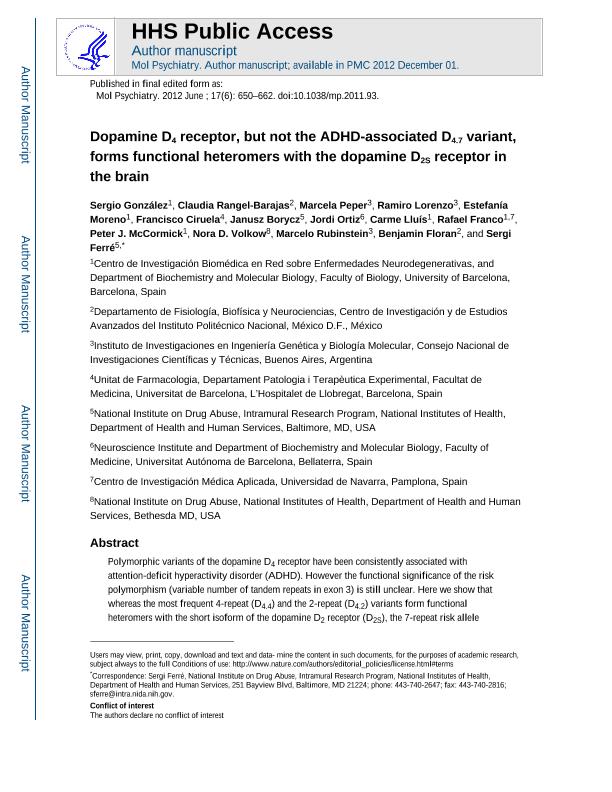Mostrar el registro sencillo del ítem
dc.contributor.author
González, S.
dc.contributor.author
Rangel Barajas, C.
dc.contributor.author
Peper, Marcela

dc.contributor.author
Lorenzo Lopez, Juan Ramiro

dc.contributor.author
Moreno, E.
dc.contributor.author
Ciruela, F.
dc.contributor.author
Borycz, J.
dc.contributor.author
Ortiz, J.
dc.contributor.author
Lluís, C.
dc.contributor.author
Franco, R.
dc.contributor.author
McCormick, P. J.
dc.contributor.author
Volkow, N. D.
dc.contributor.author
Rubinstein, Marcelo

dc.contributor.author
Floran, B.
dc.contributor.author
Ferré, S.
dc.date.available
2019-07-11T19:34:06Z
dc.date.issued
2012-06
dc.identifier.citation
González, S.; Rangel Barajas, C.; Peper, Marcela; Lorenzo Lopez, Juan Ramiro; Moreno, E.; et al.; Dopamine D 4 receptor, but not the ADHD-associated D 4.7 variant, forms functional heteromers with the dopamine D 2S receptor in the brain; Nature Publishing Group; Molecular Psychiatry; 17; 6; 6-2012; 650-662
dc.identifier.issn
1359-4184
dc.identifier.uri
http://hdl.handle.net/11336/79394
dc.description.abstract
Polymorphic variants of the dopamine D 4 receptor have been consistently associated with attention-deficit hyperactivity disorder (ADHD). However, the functional significance of the risk polymorphism (variable number of tandem repeats in exon 3) is still unclear. Here, we show that whereas the most frequent 4-repeat (D 4.4) and the 2-repeat (D 4.2) variants form functional heteromers with the short isoform of the dopamine D 2 receptor (D 2S), the 7-repeat risk allele (D 4.7) does not. D 2 receptor activation in the D 2S-D 4 receptor heteromer potentiates D 4 receptor-mediated MAPK signaling in transfected cells and in the striatum, which did not occur in cells expressing D 4.7 or in the striatum of knockin mutant mice carrying the 7 repeats of the human D 4.7 in the third intracellular loop of the D 4 receptor. In the striatum, D 4 receptors are localized in corticostriatal glutamatergic terminals, where they selectively modulate glutamatergic neurotransmission by interacting with D 2S receptors. This interaction shows the same qualitative characteristics than the D 2S-D 4 receptor heteromer-mediated mitogen-activated protein kinase (MAPK) signaling and D 2S receptor activation potentiates D 4 receptor-mediated inhibition of striatal glutamate release. It is therefore postulated that dysfunctional D 2S-D 4.7 heteromers may impair presynaptic dopaminergic control of corticostriatal glutamatergic neurotransmission and explain functional deficits associated with ADHD.
dc.format
application/pdf
dc.language.iso
eng
dc.publisher
Nature Publishing Group

dc.rights
info:eu-repo/semantics/openAccess
dc.rights.uri
https://creativecommons.org/licenses/by-nc-sa/2.5/ar/
dc.subject
Adhd
dc.subject
Dopamine Receptors
dc.subject
Glutamate
dc.subject
Receptor Heteromers
dc.subject
Striatum
dc.subject.classification
Neurociencias

dc.subject.classification
Medicina Básica

dc.subject.classification
CIENCIAS MÉDICAS Y DE LA SALUD

dc.title
Dopamine D 4 receptor, but not the ADHD-associated D 4.7 variant, forms functional heteromers with the dopamine D 2S receptor in the brain
dc.type
info:eu-repo/semantics/article
dc.type
info:ar-repo/semantics/artículo
dc.type
info:eu-repo/semantics/publishedVersion
dc.date.updated
2019-07-10T13:40:29Z
dc.journal.volume
17
dc.journal.number
6
dc.journal.pagination
650-662
dc.journal.pais
Reino Unido

dc.journal.ciudad
Londres
dc.description.fil
Fil: González, S.. Universidad de Barcelona; España
dc.description.fil
Fil: Rangel Barajas, C.. Centro de Investigación y de Estudios Avanzados del Instituto Politécnico Nacional; México
dc.description.fil
Fil: Peper, Marcela. Consejo Nacional de Investigaciones Científicas y Técnicas. Instituto de Investigaciones en Ingeniería Genética y Biología Molecular "Dr. Héctor N. Torres"; Argentina
dc.description.fil
Fil: Lorenzo Lopez, Juan Ramiro. Consejo Nacional de Investigaciones Científicas y Técnicas. Instituto de Investigaciones en Ingeniería Genética y Biología Molecular "Dr. Héctor N. Torres"; Argentina
dc.description.fil
Fil: Moreno, E.. Universidad de Barcelona; España
dc.description.fil
Fil: Ciruela, F.. Universidad de Barcelona; España
dc.description.fil
Fil: Borycz, J.. National Institutes of Health; Estados Unidos
dc.description.fil
Fil: Ortiz, J.. Universitat Autònoma de Barcelona; España
dc.description.fil
Fil: Lluís, C.. Universidad de Barcelona; España
dc.description.fil
Fil: Franco, R.. Universidad de Navarra; España
dc.description.fil
Fil: McCormick, P. J.. Universidad de Barcelona; España
dc.description.fil
Fil: Volkow, N. D.. National Institutes of Health; Estados Unidos
dc.description.fil
Fil: Rubinstein, Marcelo. Consejo Nacional de Investigaciones Científicas y Técnicas. Instituto de Investigaciones en Ingeniería Genética y Biología Molecular "Dr. Héctor N. Torres"; Argentina
dc.description.fil
Fil: Floran, B.. Centro de Investigación y de Estudios Avanzados del Instituto Politécnico Nacional; México
dc.description.fil
Fil: Ferré, S.. Centro de Investigación y de Estudios Avanzados del Instituto Politécnico Nacional; México
dc.journal.title
Molecular Psychiatry

dc.relation.alternativeid
info:eu-repo/semantics/altIdentifier/doi/https://dx.doi.org/10.1038/mp.2011.93
dc.relation.alternativeid
info:eu-repo/semantics/altIdentifier/url/https://www.nature.com/articles/mp201193
dc.relation.alternativeid
info:eu-repo/semantics/altIdentifier/url/https://pubmed.ncbi.nlm.nih.gov/21844870/
Archivos asociados
